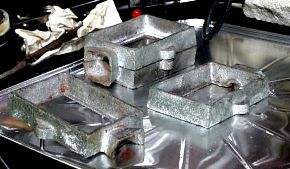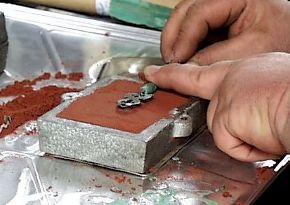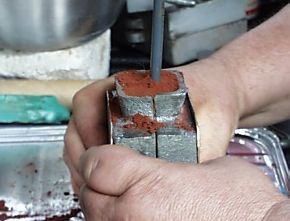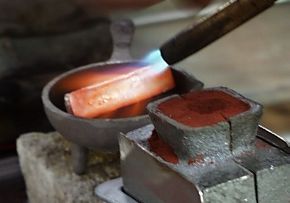|
||||
|
||||
|
||||

|
Green Sand Mold Equipment:
Small flasks made of cast iron on a cookie sheet work surface. I had not planned on going to Fenby in 2001 but when we heard there was going to be a bronze and pewter casting demo we could not resist. Jim "Paw-Paw" Wilson went with me to help share the driving. Continued on Page 5 |
|||

|
Red Green Sand:
Are you confused yet? "Green" sand means "uncured" or damp sand. It varies in actual color depending the sand, additives and how much it has been used and the type of metal poured. In iron foundries new green sand starts out tan and becomes black from use. The sand being used here is different in that it is moistened with glycerine. The glycerine does not dry out like water and is sticky. This makes it a great bonding agent for green sand. |
|||

|
Above
the green sand has been "rammed up" (packed) in one side of the flask.
The pattern for the part (an original piece) to be molded is being imbedded into the sand.
The pattern is attached with wax to a "sprue" form made from a pencil.
At left the top half of the flask is in place. The part and the surface of the sand will be sprinkled with "parting" dust. In this case we used some baby powder. This keeps the two halves of the sand mold from sticking together. |
|||

|
After ramming up
with green sand the pouring area of the sprue is filled with sand and also rammed up.
This is a very handy flask set as the sprue can be on the parting line.
In traditional "loose piece" pattern casting the sprue is cut by hand with a bent piece of sheet metal. In this case we have a sprue form so the tapered pouring area will be the only part formed by hand. Yep, its a whole lot like building sand castles. For more on patterns and mold making see our iForge demo #98. and #99 |
|||

|
Melting the Pewter
The pewter ingots are being heated in a small metal pot using a handheld MAPP torch. This is one of those examples of what CAN go wrong WILL go wrong. This particular little "melting pot" as it was labled had not been used before. A few seconds after this photo was taken one of the legs colapsed and the rim melted. . the pot was cast aluminium! Continued on Page 6 |
|||
|
|
||||
|
[ iForge | Touchmark Registry | What's New! | Rate Card | Web Rings | 21st Century | AnvilCAM ] |
||||
|
Comments to: Jock Dempsey editor@anvilfire.com |
|
|||

